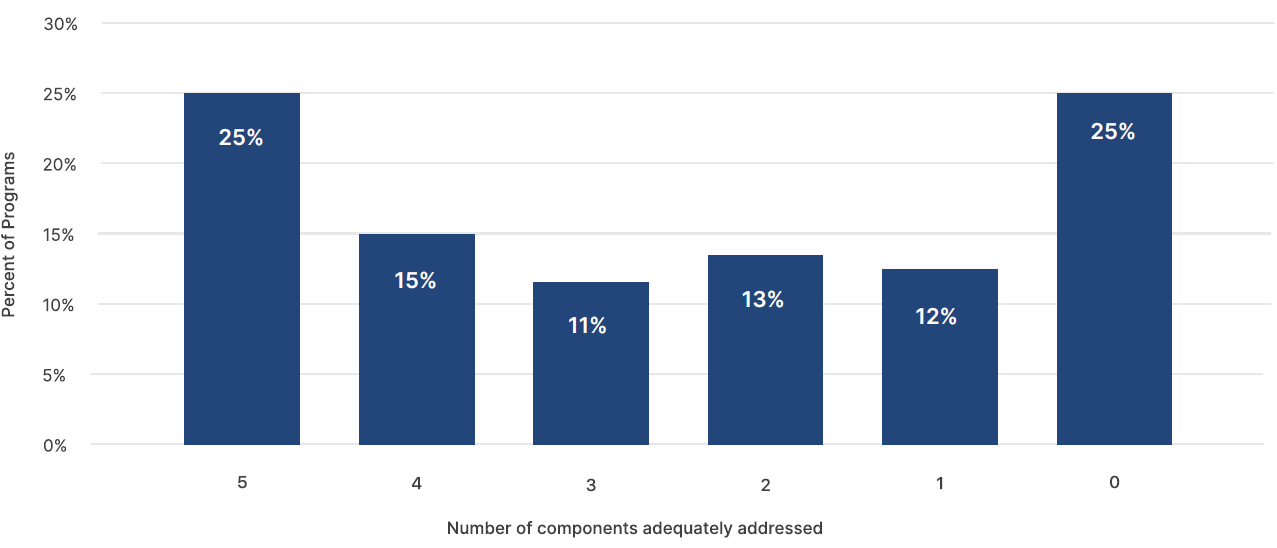Every child needs—and deserves—to learn to read. In recent years we’ve seen state and district education leaders promoting policies and making hefty investments to ensure students learn to read using the most efficient and effective methods demonstrated by decades of research, often referred to as the science of reading.
If each new cohort of teachers enters the classroom without adequate preparation in teaching reading, implementing and sustaining these efforts to improve literacy instruction will continue to fall short—and require tremendous ongoing investments. Despite more than 50 years of research1 providing a clear picture of effective literacy instruction strategies2 that can dramatically reduce the rate of reading failure, too many new teachers are not prepared because preparation programs did not teach scientifically based reading instruction, often leaving districts to make up the gap in teachers’ knowledge and skill.
In this District Trendline, we explore how districts can leverage the findings from NCTQ’s new Teacher Prep Review: Strengthening Elementary Reading Instruction report to recruit and hire teachers who are well prepared in scientifically based reading instruction.
What should elementary teachers know about reading when they enter the classroom?
The research is clear. All elementary teachers should be prepared to explicitly and systematically teach all five components of scientifically based reading instruction: phonemic awareness, phonics, fluency, vocabulary, and comprehension. NCTQ evaluates teacher preparation programs based on evidence of coverage of each of these components across four instructional approaches: instructional hours, objective measures of knowledge (e.g., tests and written assignments), practice or application opportunities (e.g., teaching a practice lesson), and background materials (e.g., textbooks).
Additionally, NCTQ examines whether programs continue to teach reading instruction practices that are contrary to the science—debunked practices such as three-cueing—and whether programs prepare aspiring teachers in how to teach reading to English language learners, struggling readers (including students with dyslexia), and students who speak language varieties other than mainstream English (such as speakers of African American English or Cajun English).
NCTQ’s new findings—a result of two years of deep engagement with literacy experts, educators, and education leaders3—provide insight into how future elementary teachers are prepared to teach reading at nearly 700 traditional undergraduate and graduate teacher preparation programs across the country.
Do teacher preparation programs adequately prepare candidates in scientifically based reading instruction?
Most teacher preparation programs aren’t meeting the mark yet. While 160 programs (25%) across the country earn high marks for providing quality instruction on all five components of scientifically based reading instruction, the majority of elementary teacher preparation programs are not adequately preparing candidates.
Where can you learn about the quality of reading instruction at prep programs near you?
NCTQ evaluates teacher education programs by assigning a letter grade based on how well they cover core components and whether they teach research-based practices. You can learn more about this evaluation process in the Methodology in Brief.
Programs earning a high score (A or B) in the NCTQ evaluation are found in nearly every state across the country. To find top-quality programs in your state, use the Teacher Prep Review Database. This database also provides detailed information about the specific strengths and limitations of each program, which allows you to customize your search for potential teachers and inform the type of professional development offered to newly hired teachers.
What can districts do to secure teachers prepared to teach scientifically based reading instruction?
1. Be strategic in recruiting new teachers. While most programs do not fully address all five core components of the science of reading, 1 in 4 programs do adequately address all components, and these stronger programs can be found in most states. To the extent possible, focus hiring efforts on teachers from preparation programs adequately teaching scientifically based reading instruction. The detailed analysis for each program provides information about which components programs adequately cover; this can also help prioritize, for example, hiring teachers from programs providing adequate instruction on phonemic awareness when hiring for early elementary grades.
Looking at programs’ attention to reading can turn up some surprising results. For example, graduate programs are less likely to provide adequate preparation in reading. Despite preparing candidates for the same job, graduate programs provide less comprehensive coverage of the five components across all measures compared with undergraduate programs. While some graduate programs offer strong preparation in reading, this is the exception.
Number of components programs adequately address

Click here to see results in your state.
2. Prioritize partnerships for field experiences and student teaching with programs committed to teaching scientifically based reading instruction. These partnerships can encourage more programs to strengthen their reading instruction and can ease the process of hiring teachers who have been prepared in the science of reading. (Read more about how hosting student teachers can solve a range of staffing challenges.) Adding to these benefits, student teachers will have the opportunity to learn about the reading approaches your district uses, which can put them at an advantage if they start teaching in your district. Further, student teaching creates a mutually beneficial partnership between school districts and prep programs, offering an ideal opportunity for districts to provide feedback to programs about the strengths and weaknesses of their candidates, especially in reading instruction.
3. Consider adding some questions about reading instruction into the interview process. Because preparation programs vary widely in their attention to reading instruction, additional vetting during the interview process can be a useful check on candidates’ knowledge of this critical area. As one example of what to be on the lookout for, NCTQ’s analysis found 2 out of 3 programs fail to adequately address phonemic awareness. This omission is concerning because strong phonemic awareness skills allow children to isolate, blend, segment, and manipulate phonemes (the smallest units of sound within a language system) in different ways, priming early readers to develop phonics skills, in which they connect the sounds they hear to the letters they see. This skill sets the stage for decoding, which is necessary for fluency, vocabulary, and ultimately comprehension.
As a further check of teachers’ knowledge of reading, if your state requires a licensure test on science of reading instruction, consider asking for scores on this test (or requiring candidates to pass the test prior to being hired, if your state offers some leniency about when teachers take it).
4. When hiring teachers from programs that provide little instruction in the science of reading, offer supplemental professional development. A full quarter of prep programs do not adequately address any of the five components; new teachers from these programs will likely need some additional training. Further, nearly one-third of programs do not require candidates to practice teaching any specific core components of reading, despite widespread agreement among practitioners and researchers on the importance of practice. If your new hires haven’t had an opportunity to practice specific components of reading instruction, this may be an area in which mentor teachers can support your novice teachers.
Programs also provide little preparation in teaching reading to a range of learners (English language learners, struggling readers including those with dyslexia, and students who speak language varieties other than mainstream English), with the majority of programs providing less than two hours of instruction on how to support any learner population in reading.
For examples of professional development aligned with the science of reading, see NCTQ’s action guide: The Four Pillars to Reading Success.
5. Be alert for practices that are contrary to the science of reading. If your district hires teachers from programs still teaching reading instruction practices that are contrary to the science of reading, communicate to the programs that this may jeopardize the hiring of their candidates or the placement of them in student teaching positions. Additionally, it may be helpful to clarify to new teachers early on that these contrary practices are not used in your district and do not support student learning.
Over 40% of programs are still teaching multiple practices contrary to the research—such as three-cueing or miscue analysis—which can impede student learning. Even when presented alongside research-based methods, preparation programs’ instruction on these debunked practices legitimizes them and can cause confusion about which methods teachers should use in the classroom.
6. Keep state leaders informed. As you analyze the strengths and limitations of new teachers entering your schools, consider sharing information with your state leaders about how teachers from various programs perform, so they keep teacher prep front of mind in efforts to improve reading instruction.
States vary widely on how well their teacher preparation programs address reading instruction, but NCTQ’s data points to state policy as a way to improve the quality of teacher preparation in reading. Some states that stand out—like Mississippi and Colorado—have developed robust and specific teacher preparation standards and accountability measures as part of a systemwide effort to improve reading outcomes for all students. See how programs in your state compare.
See the full NCTQ report and program data, Teacher Prep Review: Strengthening Elementary Reading Instruction.
Interested in how teacher preparation programs in your area do in math preparation? Who’s ready to teach elementary mathematics? How school districts can use NCTQ’s Teacher Prep Review Elementary Mathematics findings in their recruiting and hiring decisions.
More like this

Ten maxims: What we’ve learned so far about how children learn to read by Dr. Reid Lyon
Together we can address the literacy crisis head-on, reversing historical patterns of inequity and changing the lives of millions of our children.

Who’s ready to teach elementary mathematics?
How school districts can use NCTQ’s Teacher Prep Review Elementary Math standard findings in their recruiting and hiring decisions

Getting districts and teacher prep on the same page on reading pays off
There’s clear evidence that teachers are more effective reading instructors with special education students when both their preservice preparation and their school district emphasize evidence-based reading practices.
Endnotes
- National Reading Panel (U.S.), National Institute of Child Health, Human Development (U.S.), National Reading Excellence Initiative, National Institute for Literacy (U.S.), & United States Department of Health. (2000). Report of the National Reading Panel: Teaching children to read: An evidence-based assessment of the scientific research literature on reading and its implications for reading instruction: Reports of the subgroups. National Institute of Child Health and Human Development, National Institutes of Health. Retrieved from https://www.nichd.nih.gov/sites/default/files/publications/pubs/nrp/Documents/report.pdf
- Foorman, B., Beyler, N., Borradaile, K., Coyne, M., Denton, C. A., Dimino, J., Furgeson, J., Hayes, L., Henke, J., Justice, L., Keating, B., Lewis, W., Sattar, S., Streke, A., Wagner, R., & Wissel, S. (2016). Foundational skills to support reading for understanding in kindergarten through 3rd grade (NCEE 2016-4008). Washington, DC: National Center for Education Evaluation and Regional Assistance (NCEE), Institute of Education Sciences, U.S. Department of Education.
- The NCTQ Reading Foundations standard was updated prior to this release based on input from an Expert Advisory Panel (to advise on content);, a Technical Advisory Group (to advise on methodology);, and a survey of nearly 240 respondents from the education field, including leaders from state education agencies and school districts, as well as teacher preparation programs. More details on the methodology, revision process, and research underpinning the standard are available in the Reading Foundations Technical Report.

